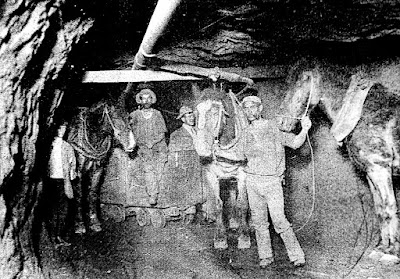Lowering a horse for work underground. Published in Norma King's Colourful Tales of the Goldfields.
The first known recorded use of ponies underground in Great Britain was in the Durham coalfield in 1750. The Mines and Collieries Act of 1842 barred women and children under 10 (later amended to 13) years of age from working underground, which led to the widespread use of horses and ponies in mining. Typically, they would work an eight-hour shift each day, during which they might haul 30 tons of coal in tubs on the underground mine railway. One 1911 writer estimated that the average working life of coal mining mules was only 3 ½ years, where 20-year working lives were common on the surface.
In 1953, vacuumed grooming devices were introduced so the groomers would be less exposed to lung contamination, which obviously indicates the horses in coal mines were constantly exposed to poor air quality. (Sunday Times, 30 August 1953, p18)
In Western Australia, the Sons of Gwalia mine near Leonora had a long history of using pit horses. In June 1913, it was reported that “a nag was securely tied to an open skip and lowered down the shaft. This is one way of getting over the alien question, and we should think that the horse would prove to be more satisfactory than the 'Ski'.” (The Leonora Miner, 7 June 1913, p2 https://trove.nla.gov.au/newspaper/article/210185712)
Unrest was brewing in the goldfields at the time as many Italians and Austrians were employed on the mines as they were willing to accept lower pay and more dangerous work. Mine managers complained that they could not get enough 'Britishers' to work on their mines. The 'aliens' were good workers and many came with a great experience of mining from overseas.
To counteract this, the Moore Government introduced an Act which stated that all underground workers must be able to speak the English language readily and intelligibly and to read it whether it be printed or written. In 1913, the act was vigorously upheld, and inspectors interviewed migrant workers to see if they could pass the English standard. Companies were fined 50 pounds if they employed a worker who failed the test. Managers complained that the system was unjust, as a worker may pass one inspection to fail at a later date. A bill was introduced in 1913 to limit the number of migrant workers to no more than 1:10 and to reduce the working week to 44 hours, but it did not pass. This would have been what the report alluded with regards to the 'alien' question which the horse helped alleviate. (“Foreigners in Mines”, The West Australian 4 July 1913, p7: https://trove.nla.gov.au/newspaper/article/26878783)
There was a fire in the surface plant of the mine in January 1921 which caused the mine to cease production. At the time there were 20 horses stabled underground, so they were brought to the surface until mining operations began again. (“Fire on Sons of Gwalia” Western Argus (Kalgoorlie) 25 January 1921 p 13: https://trove.nla.gov.au/newspaper/article/34243215)
Sons of Gwalia was reported to be the only gold mine using horses underground in Western Australia. It was reported they had 25 in 1938 that were stabled underground and they were only raised to the surface if they were sick or needed a rest. The crosscuts and levels of the mine were of considerable length. The inclined shaft had a depth of 4,800 feet and it had the longest pull of any mine in the state at the time, which is why they determined they required horses. They were used to pull the ore trucks along the rails underground. (The Leonora Miner, 2 June 1928 p 3: https://trove.nla.gov.au/newspaper/article/210182014) (The Sunday Times (Perth) 19 June 1938 p22: https://trove.nla.gov.au/newspaper/article/58810182)
In 1941 they had 28 light draught horses working shifts with the men on various levels of the 5036-foot underlay shaft. It was reported that “Old Duff” lived in the deep levels pulling ore for more than 15 years and several other horses had been underground for 13 or 14 years. They had not gone blind from the constant darkness and apparently rarely suffered any illness. Mining Superintendent Rowe stated that they were well looked after with automatic feeders and water underground, with a veterinarian surgeon employed by the mine. If they got 'a bit seedy', they were bought above-ground to do light work or rest. He stated that they gave cheap and efficient service. (The Daily News, Perth 15 November 1941 p 10: https://trove.nla.gov.au/newspaper/article/78567677)
A local Italian man named Milano, also known as Burglar Bill, broke in horses for use in the mine in the 1930s. When they had been broken in, he took them down to accustom them to their work and the darkness where they were to likely live for the rest of their lives.
Horses were used for this work in the Sons of Gwalia mine until they were replaced in the mid-1950s with electric locomotives.
However, horses were also in use in the coal mines of Collie underground, so perhaps the report was only referring to gold mines. The picture below is from a newspaper article on 25 May 1946 (Daily News, p25). At this time they had 23 Pit Ponies hauling skips in places where it was simpler to use horses than winch power. They were described as strong, sleek and docile.
The above horse was reported to be the last working pit pony in Australia. It worked underground at a coal mine in Collinsville, Queensland and was retired in 1986.
(https://pitponies.com.au/about-us/history-mining-equipment-movers/last-pit-pony/)
The video below is not from Western Australia but gives an insight as to how they were treated within Australia at the time.
Although the horses were no doubt treated affectionately by the underground workers and mining staff, their lives spent mostly in darkness and confined spaces pulling carts is hard for us to comprehend today.
Copyright Lorraine Kelly 2020. Revised 11/3/2020




No comments:
Post a Comment